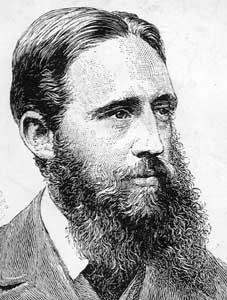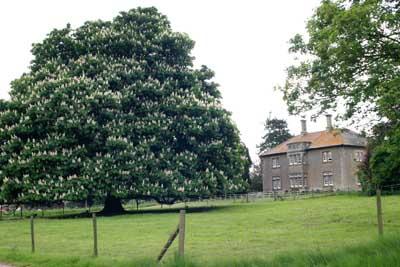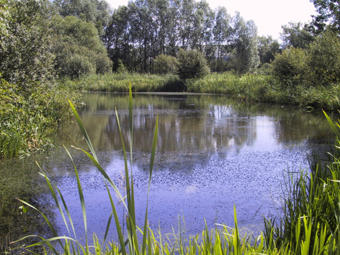The Trust was estabished on 13 September 2005 with the aim to protect and enhance the special landscape of high wildlife, archaeological and literary importance between Coate Water Site of Special Scientific Interest and the North Wessex Downs Area of Outstanding Natural Beauty.
Saturday, December 03, 2005
Trust publish their vision for Jefferies Land at Coate and a history of the area
PRESS RELEASE
3 December 2005
Trust publish their vision for Jefferies Land at Coate and a history of the area
The Jefferies Land Conservation Trust has published two pamphlets that provide a guide to the literary and historic interest in land at Coate and their vision for an alternative use of this special area.
The first pamphlet entitled Coate and Richard Jefferies was written by a local historian. John Chandler, who lives near Salisbury, examines the links between the Victorian author Richard Jefferies and the land where Jefferies was born and raised at Coate. The report discusses this area in the context of the life and career of Jefferies, its topography and character during the period of his acquaintance with it, and major references to the area in his works. It concludes with an assessment of Jefferies as a topographical writer, as formed by literary opinion since his death, and considers the importance of the Coate area in his works.
The second pamphlet An alternative use for Jefferies Land forms the basis of the Trust’s vision [1] for the area. It looks at the recent history and how the existing fields and buildings could be put to best use for the future economic, educational, social and environmental well-being of Swindon and its residents.
Jean Saunders, Secretary of the Trust said:
“We are delighted to make these pamphlets available to the public who might not be well acquainted with the special qualities of the area. At the same time, we want to ensure that the greatest assets are protected and enhanced in order that future generations of Swindonians can derive as much pleasure from them as their ancestors.”
The pamphlets can be obtained by sending postage stamps to the value of £1 to Pear Tree Cottage, Longcot, SN7 7SS. Copies can be picked up on Saturday 10th December at 1pm at the Community Crossroads, the former railway museum in Faringdon Road, where the Trust will be holding a special meeting.
For more information contact Jean Saunders on 01793 783040
-ENDS-
Editor’s notes
[1] The main elements of the Trust’s Vision are to:
§ maintain the landscape setting of Coate Water in the countryside; to preserve the adjoining Jefferies land as an ideal place for "rambles" to see the links to Jefferies' writing; and .... just simply a "place" to relax and enjoy.
§ enhance the biodiversity of the Site of Special Scientific Interest and the nature reserves at Coate Water, Day House Copse and Burderop Wood North. Extensive new habitats and wildlife corridors would be created, stressing the ecological value of streams, trees and hedges, etc.
§ provide a centre to study and appreciate literary landscapes as an inspiration to UK writers; the history of British nature writing; and to include a special focus on Richard Jefferies' key role in this evolution ;
§ demonstrate and study traditional crafts and environmentally sensitive alternatives that reduce man’s impact on the land, including managing land organically as an educational tool and for local food production;
§ feature the archaeological qualities of the area dating back about 3000 years and the links to others at Liddington Hill and Barbury Castle;
§ provide educational opportunities for local children linking in with local schools and community groups
Wednesday, November 30, 2005
Trust meeting 10 December
The meeting will be held at The Community Crossroads [the former Railway Museum] in Faringdon Road, Swindon.
There will be an opportunity to update Members about the Trust’s emerging vision for the land at Coate.
ADOPTION OF CONSTITUTION
This proposes rules by which the Trust will operate. They follow a model provided by the Charity Commission. The draft document also contains a mission and policy statement and describes briefly how the organisation is structured. Once the Constitution is agreed, the Trustees will apply to the Charity Commission in order to formally register the Trust as a Charity.
APPOINTMENT OF HONORARY OFFICERS AND TRUSTEES
Trust members will elect from amongst themselves a Chair, a Secretary and Treasurer and up to five additional trustees.
For more information contact Jean Saunders on jefferies_lct@tiscali.co.uk or phone 01793 783040
Friday, October 28, 2005
Just Before Winter

A rich tint of russet deepened on the forest top, and seemed to sink day by day deeper into the foliage like a stain; riper and riper it grew, as an apple colours. Broad acres these of the last crop, the crop of leaves; a thousand thousand quarters, the broad earth will be their barn. A warm red lies on the hill-side above the woods, as if the red dawn stayed there through the day; it is the heath and heather seeds; and higher still, a pale yellow fills the larches. The whole of the great hill glows with colour under the short hours of the October sun; and overhead, where the pine-cones hang, the sky is of the deepest azure. The conflagration of the woods burning luminously crowds into those short hours a brilliance the slow summer does not know.
The frosts and mists and battering rains that follow in quick succession after the equinox, the chill winds that creep about the fields, have ceased a little while, and there is a pleasant sound in the fir trees. Everything is not gone yet. In the lanes that lead down to the 'shaws' in the dells, the 'gills,' as these wooded depths are called, buckler ferns, green, fresh, and elegantly fashioned, remain under the shelter of the hazel-lined banks. From the tops of the ash wands, where the linnets so lately sang, coming up from the stubble, the darkened leaves have been blown, and their much-divided branches stand bare like outstretched fingers. Black-spotted sycamore leaves are down, but the moss grows thick and deeply green; and the trumpets of the lichen seem to be larger, now they are moist, than when they were dry under the summer heat. Here is herb Robert in flower--its leaves are scarlet; a leaf of St. John's-wort, too, has become scarlet; the bramble leaves are many shades of crimson; one plant of tormentil has turned yellow. Furze bushes, grown taller since the spring, bear a second bloom, but not perhaps so golden as the first. It is the true furze, and not the lesser gorse; it is covered with half-opened buds; and it is clear, if the short hours of sun would but lengthen, the whole gorse hedge would become aglow again. Our trees, too, that roll up their buds so tightly, like a dragoon's cloak, would open them again at Christmas; and the sticky horse-chestnut would send forth its long ears of leaves for New Year's Day. They would all come out in leaf again if we had but a little more sun; they are quite ready for a second summer.
Deliberate decay?

It would appear to be so.
Monday, October 24, 2005
On the Downs
The Downs are lit with sunlight - the night will cover them presently - but the mind will sigh as eagerly for these things as in the glory of day. Sooner or later there will surely come an opening in the clouds, and a broad beam of light will descend. A new thought scarcely arrives in a thousand years, but the sweet wind is always here, providing breath for the physical man. Let hope and faith remain, like the air, always, so that the soul may live. That such a higher thought may come is the desire - the prayer which springs on viewing the blue hill line, the sea, the flower...
The soul knows itself, and would live its own life.'
the music of water

'No one else seems to have seen the sparkle on the brook, or heard the music at the hatch, or to have felt back through the centuries... Perhaps after all I was mistaken, and there never was any such place or any such meadows, and I was never there.'
Richard Jefferies
'My Old Village', Field and Hedgerow
Monday, October 03, 2005
Power of nature

Richard Jefferies
Tom and I have returned from a holiday in Dorset where much pride of place is given to local writers. Thomas Hardy was undoubtedly influenced by Richard Jefferies. T E Lawrence's [Lawrence of Arabia] retreat at Clouds Hill had Jefferies' books displayed on the shelves. John Fowles has gone so far as to sign the Save Coate petition.
"If we had never before looked upon the earth, but suddenly came to it man or woman grown, set down in the midst of a summer mead, would it not seem to us a radiant vision? The hues, the shapes, the song and life of birds, above all the sunlight, the breath of heaven, resting on it; the mind would be filled with its glory unable to grasp it, hardly believing that such things could be mere matter ... too beautiful to be long watched lest it should fade away."
Coate was very special then as it is to those of us now who see with Jefferies eyes. Let it be a literary attraction for tourists who want to marvel at the images that created such passionate prose.
Saturday, October 01, 2005
Jessie Baden's home
Thursday, September 22, 2005
Coate Water nature reserve
Another welcome return to the nature reserve is the otter. Fifteen species of dragon-fly have been recorded and four species of bat swoop over the lake to feed.
Wednesday, September 21, 2005
Jefferies' favourite view

Liddington Hill was a favoured haunt of Richard Jefferies. He regularly walked there to get away from people. The experience uplifted his soul as described in the opening page of 'The Story of My Heart', his autobiography.
Now the views are scarred by Swindon's expansion - not least of all the new hospital to the right of the picture. Coate Water is still visible from the hill whilst the fields in the foothills to the Downs still form a grand setting for the town.
Tuesday, September 20, 2005
Monday, September 19, 2005
Sunday, September 18, 2005
ACTION TO PROTECT LITERARY LANDMARK

Saturday, September 17, 2005
New conservation trust is born

PRESS RELEASE
'Jefferies Land' Conservation Trust
12 September 2005
New conservation trust is born
The Save Coate coalition is backing the launch of a new conservation trustin a bid to propose an alternative use for the countryside east and south ofCoate Water Country Park.
The trust is adopting the name, the 'Jefferies Land' Conservation Trust, in honour of the Coate born Victorian author, Richard Jefferies who lived from1848 to 1887.
The Trust's long-term vision for the area would place Swindon squarely onthe map as a literary heritage site, as a place for visitors to enjoy aspecial rural climate, and as a centre for study of the environment and historic landscapes.
The group hopes to create extensive new habitats thatlink up the nature reserves at Coate Water, Day House Copse and BurderopWoods and ensure that the open views between the country park and Liddington Hill are protected forever from development. Given access to existing buildings, the Trust aspires to open study centres to focus on literary landscapes as an inspiration to British writers and to provide educational opportunities for local people to appreciate nature, art and the rich history of the area.
A spokesperson for the Trust said:
"In his books, Jefferies immortalised every plant and creature existing inthe Coate area - nothing escaped his keen eye. As England's foremost natureand countryside writer, he must be turning in his grave at the latest threatto build on his beloved homeland. We believe that Jefferies would approve ofour vision for the area and that we will get the support of the tens of thousands of local people who have backed the Save Coate petition."
ENDS



